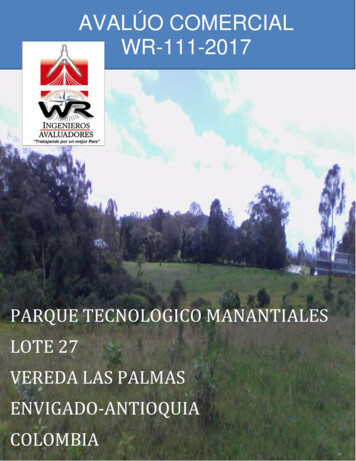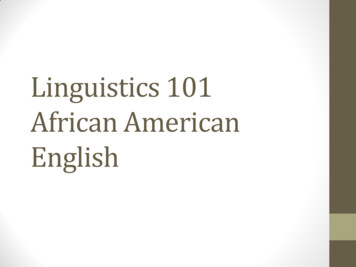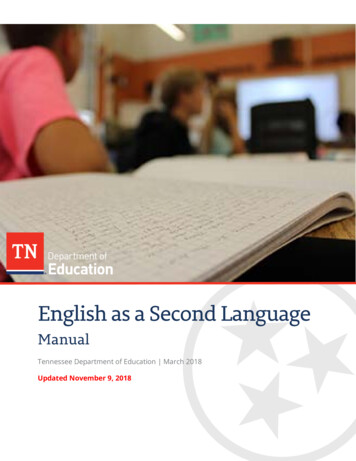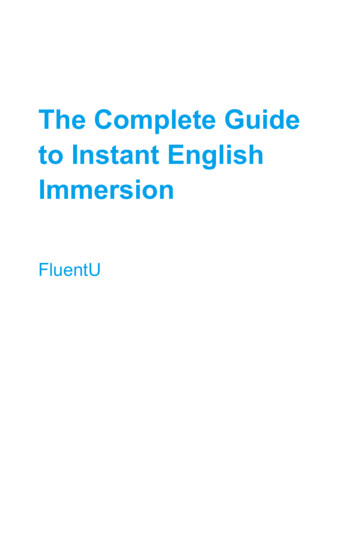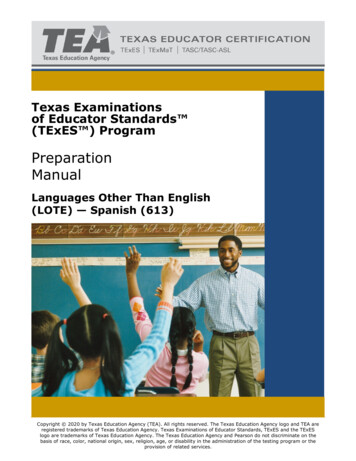
Transcription
Texas Examinationsof Educator Standards (TExES ) ProgramPreparationManualLanguages Other Than English(LOTE) — Spanish (613)Copyright 2020 by Texas Education Agency (TEA). All rights reserved. The Texas Education Agency logo and TEA areregistered trademarks of Texas Education Agency. Texas Examinations of Educator Standards, TExES and the TExESlogo are trademarks of Texas Education Agency. The Texas Education Agency and Pearson do not discriminate on thebasis of race, color, national origin, sex, religion, age, or disability in the administration of the testing program or theprovision of related services.
Table of ContentsAbout The Test .4The Domains .7The Standards .8Domains and Competencies.9Domain I — Instruction and Assessment .9Domain II — Cultural Understanding . 12Domain III — Interpretive Listening . 12Domain IV — Interpretive Reading . 13Domain V — Written Expression. 14Domain VI — Oral Expression . 15Approaches to Answering Multiple-Choice Questions . 16How to Approach Unfamiliar Question Formats . 16Question Formats. 17Single Questions . 18Questions Based on Instructional Practices . 18Questions with Stimulus Material . 20Multiple-Choice Practice Questions . 30Answer Key and Rationales . 52Succeeding on Written Expression Constructed-Response Tasks . 68Written Expression Constructed-Response Practice Tasks . 71Succeeding on Oral Expression Constructed-Response Tasks . 76Oral Expression Constructed-Response Practice Tasks . 80NOTE: After clicking on a link, right click and select “Previous View” to go back to original text.TExES Languages Other Than English (LOTE) — Spanish (613)2
Succeeding on Instructional Practices Constructed-Response Tasks . 85Instructional Practices Constructed-Response Practice Tasks . 88Study Plan Sheet . 91Preparation Resources . 92NOTE: After clicking on a link, right click and select “Previous View” to go back to original text.TExES Languages Other Than English (LOTE) — Spanish (613)3
About The TestTest NameLanguages Other Than English (LOTE) — SpanishTest Code613Time5 hoursNumber of Questions120 multiple-choice questions and8 constructed-response tasksFormatComputer-administered test (CAT)The TExES Languages Other Than English (LOTE) — Spanish (613) test is designedto assess whether a test taker has the requisite knowledge and skills that an entrylevel educator in this field in Texas public schools must possess. The 120 multiplechoice questions and 8 constructed-response tasks are based on the LOTE–Spanishtest framework. The test may contain questions that do not count towardthe score. Your final scaled score will be based only on scored questions.NOTE: After clicking on a link, right click and select “Previous View” to go back to original text.TExES Languages Other Than English (LOTE) — Spanish (613)4
SectionCompetencyDomainNumber ofTimingWeight36 Multiple-ChoiceApprox.20%Questions50 minutesQuestionsIIntercultural and Cross-IIInterpretiveCultural ConnectionsIIIMode: Listeningwith Culturaland LinguisticKnowledge(multiplechoice)(30 scored plusLiteral6 not scored)Comprehension of OralMessagesInferential andInterpretiveComprehensionof Oral MessagesIIIntercultural and Cross-II39 Multiple-ChoiceInterpretiveCultural ConnectionsIVQuestionsMode: Readingwith Culturaland LinguisticKnowledge(multiplechoice)50 minutes21.4%(32 scored plusLiteral Comprehension of7 not scored)Written CommunicationInferential andInterpretive Analysis ofWrittenCommunicationIIIPractice UsingWritingCharacter Selector1 Task5 tingPresentationalV3 Constructed-50 minutes12%3 Constructed-Approx.12%Response15 minutesResponseStructuresTasks:Writing1) Response toProficiencyEmail, MemoWritingor LetterIntegrated2) Opinion/PositionSkills: WritingEssay(constructed3) Integratedresponse)Skills: WritingVSpeakingIntegratedProficiencySkills: SpeakingPresentationalSpeakingVITasks:1) IntegratedSkills: Speaking2) OralInterpersonalPresentation orSpeakingSituation/Opinion(constructedresponse)3) SimulatedConversationNOTE: After clicking on a link, right click and select “Previous View” to go back to original text.TExES Languages Other Than English (LOTE) — Spanish (613)5
Optional Break: 10 minutesSectionCompetencyDomainNumber ofVITheories andI45 Multiple-ChoiceInstructionalPrinciples of LanguageQuestionsPracticesLearning(40 scored plusTimingWeight45 minutes26.6%35 minutes8%Questions(multiplechoice)5 not scored)Theories and Practices ofSecond-LanguageInstruction andAssessmentInstructional andAssessment Strategiesfor Implementing theTEKS for LOTEVIITheories andInstructionalPrinciples of dresponse)I2 Constructed-1) Lesson PlanTheories and Practices of2) EssaySecond-LanguageInstruction andAssessmentInstructional andAssessment Strategiesfor Implementing theTEKS for LOTENOTE: After clicking on a link, right click and select “Previous View” to go back to original text.TExES Languages Other Than English (LOTE) — Spanish (613)6
The DomainsDomainDomain TitleApprox.Percentageof Test34.6%Standards AssessedI.Instruction and AssessmentII.Cultural UnderstandingIII.Interpretive Listening16.7%LOTE–Spanish: IV and VIV.Interpretive Reading16.7%LOTE–Spanish: IV and VIV.Written Expression12%LOTE–Spanish: VIIIVI.Oral Expression12%LOTE–Spanish: VII8%LOTE–Spanish: I–IIILOTE–Spanish: IVNOTE: After clicking on a link, right click and select “Previous View” to go back to original text.TExES Languages Other Than English (LOTE) — Spanish (613)7
The StandardsLOTE Standard IThe LOTE teacher understands language learning theories and principles of secondlanguage acquisition and uses this knowledge to plan instruction and assessmentthat promotes success for all students in all areas of language learning as definedin the Texas Essential Knowledge and Skills (TEKS).LOTE Standard IIThe LOTE teacher understands assessment and instruction and applies thisknowledge to monitor and promote student progress in all areas of languagelearning as defined in the Texas Essential Knowledge and Skills (TEKS).LOTE Standard IIIThe LOTE teacher implements the Texas Essential Knowledge and Skills (TEKS),enabling students to communicate in the target language, through which they gainknowledge and understanding of other cultures, connect with other disciplines andacquire information, make comparisons that develop insight into the nature oflanguage and culture and participate in multilingual communities at home andaround the world.LOTE Standard IVThe LOTE teacher understands the nature of culture and the connections betweenlanguage and culture, and understands the practices, products and perspectives ofthe culture(s) in which the target language is used.LOTE Standard VAs a demonstration of listening proficiency, the LOTE teacher is able to deriveessential information, interpret meaning and evaluate oral communications in thetarget language (as applicable to the target language).LOTE Standard VIAs a demonstration of reading proficiency, the LOTE teacher is able to deriveessential information, interpret meaning and evaluate a variety of authenticmaterials written in the target language (as applicable to the target language).LOTE Standard VIIAs a demonstration of speaking proficiency, the LOTE teacher is able to constructeffective interpersonal and presentational oral discourse in the target language (asapplicable to the target language).LOTE Standard VIIIAs a demonstration of writing proficiency, the LOTE teacher is able to write effectiveinterpersonal and presentational discourse in the target language (as applicable tothe target language).NOTE: After clicking on a link, right click and select “Previous View” to go back to original text.TExES Languages Other Than English (LOTE) — Spanish (613)8
Domains and CompetenciesThe content covered by this test is organized into broad areas of content calleddomains. Each domain covers one or more of the educator standards for this field.Within each domain, the content is further defined by a set of competencies. Eachcompetency is composed of two major parts: The competency statement, which broadly defines what an entry-leveleducator in this field in Texas public schools should know and be able to do. The descriptive statements, which describe in greater detail the knowledgeand skills eligible for testing.Domain I — Instruction and AssessmentCompetency 001: The LOTE teacher knows and understands language-learningtheories and theories of second-language acquisition and their application to LOTEinstruction and assessment to promote the learning goals defined in the TexasEssential Knowledge and Skills (TEKS) for LOTE and promote all students’ successas language learners.The beginning teacher:A. Understands theories and processes of interlanguage development, includingpredictable patterns in second-language development and factors affectingthe time required to learn a language.B. Understands the theories of cognitive processing that underlie first- andsecond- language acquisition.C. Understands general learning theories and processes relevant to languageacquisition, including theories and processes of second-language instructionand assessment (e.g., communicative approaches, content-basedapproaches).D. Understands the roles of various learning styles (e.g., visual, tactile, aural) insecond-language acquisition and plans, selects and creates a variety ofinstructional and assessment materials that are responsive to variouslanguage-learning styles and that raise students’ awareness of their ownlanguage-learning styles.E. Understands the roles of individual students’ characteristics (e.g., motivation,first-language background), social processes and linguistic factors (e.g.,language transfer, overgeneralization) and other factors (e.g., familyattitudes and behaviors) in second-language acquisition.F. Applies theories and processes that guide work with particular studentpopulations in the LOTE classroom (e.g., heritage learners, gifted andtalented, special needs) to plan, select and create instructional andassessment strategies that enhance language acquisition and success for allstudents.NOTE: After clicking on a link, right click and select “Previous View” to go back to original text.TExES Languages Other Than English (LOTE) — Spanish (613)9
G. Applies theories and processes of second-language learning, instruction andassessment in planning, selecting and creating a variety of instructional andassessment practices and sequences that are based on the learning goalsdefined in the Texas Essential Knowledge and Skills (TEKS) for LOTE.H. Knows how to expand and enrich existing home background of heritagelanguage/dialect of native speakers of the language.Competency 002: The LOTE teacher understands and applies theories, strategiesand practices of second-language instruction and assessment to promote students’progress in all areas of language learning as defined in the Texas EssentialKnowledge and Skills (TEKS) for LOTE.The beginning teacher:A. Understands and applies knowledge of instructional strategies, materials,technologies and activities to plan instruction that is appropriate for students’varied interests, needs, learning styles, motivations and backgrounds and forfostering students’ progress in all areas of language learning.B. Knows and understands a variety of informal and formal assessmentmethods for identifying and interpreting students’ affective and cognitiveneeds (e.g., attitudes about language learning, language strengths andweaknesses, cultural understandings); for determining students’ proficiencylevels; for monitoring students’ progress; for reflecting on, adjusting andimproving teaching practice; and for guiding students’ learning.C. Plans, selects and implements a variety of informal and formal assessmentmethods, tools and rubrics for evaluating and promoting students’interpersonal, interpretive and presentational communication skills in allmodalities.D. Applies knowledge of instructional strategies to encourage students’ selfevaluation and self-monitoring, including self-selection of personal learningstrategies relevant to second-language acquisition.E. Understands strategies for selecting, adapting and developing instructionalstrategies and informal and formal assessments for evaluating students’language acquisition as reflected in state and national guidelines (e.g., TEKSfor LOTE, American Council on the Teaching of Foreign Languages [ACTFL]Performance Guidelines for K–12 Learners).F. Selects, creates, adapts and promotes age-appropriate and languageproficiency-level-appropriate materials, strategies and applications of variousmedia to foster language learning and promote cultural understanding.NOTE: After clicking on a link, right click and select “Previous View” to go back to original text.TExES Languages Other Than English (LOTE) — Spanish (613)10
G. Understands strategies for promoting meaningful, proficiency-levelappropriate discourse in the target language by providing comprehensibleinput and opportunities to interact, negotiate meaning, speakextemporaneously, make cultural connections and participate in extendedconversational interactions.Competency 003: The LOTE teacher understands and applies strategies andapproaches for implementing the TEKS for LOTE to promote students’ ability tocommunicate in the target language, gain knowledge and understanding of othercultures, connect with other disciplines and acquire information, make comparisonsthat develop insight into the nature of language and culture and participate inmultilingual communities at home and around the world.The beginning teacher:A. Applies knowledge of instructional and assessment strategies, practices andsequences to facilitate the development of interpersonal communication inthe target language.B. Applies knowledge of instructional and assessment strategies, practices andsequences to facilitate the development of interpretive communication in thetarget language, including strategies for guiding students in the selection ofmaterials for independent reading, listening and viewing in the targetlanguage.C. Applies knowledge of instructional and assessment strategies, practices andsequences to facilitate effective communication in the target language,including strategies for making speech comprehensible.D. Understands the use of instructional and assessment activities, materials andpractices that integrate culturally significant practices, products andperspectives into the language-learning environment.E. Understands and applies strategies for guiding students in theircomprehension of the nature of language and culture through comparisonsbetween the target cultures and the students’ own language(s) andculture(s), including strategies for helping students understand the influenceof one language or culture on another.F. Understands and applies strategies for creating interdisciplinary learningexperiences to help students explore connections among disciplines;integrate knowledge, skills and methods of inquiry from different subjectareas; build vocabulary in other disciplines; explore connections between thetarget language and their own career goals; and make personal connectionsacross disciplines through the use of the target language.G. Understands and applies strategies for connecting what is taught in theclassroom to what is experienced in everyday life and can make culturalconnections across disciplines.NOTE: After clicking on a link, right click and select “Previous View” to go back to original text.TExES Languages Other Than English (LOTE) — Spanish (613)11
H. Knows how to identify, plan and promote opportunities for students toparticipate in extracurricular activities (e.g., contests, field trips) and localethnic organizations and events, including opportunities to work withindividuals from a variety of backgrounds and cultures to establishcommunity learning activities, and opportunities to study, travel and workabroad and at home.Domain II — Cultural UnderstandingCompetency 004: The LOTE teacher understands the connections betweenlanguage and culture, including the interactions among cultural products, practicesand perspectives within the target language cultures.The beginning teacher:A. Understands and analyzes connections among cultural products, practicesand perspectives in the target cultures.B. Knows and understands that there are multiple perspectives within the targetlanguage cultures and can analyze and interpret ideas from diverseperspectives within these cultures.C. Understands and analyzes important similarities and differences amongproducts, practices and perspectives of target cultures and of multiplecultures within the United States.D. Understands and analyzes the factors within the target cultures thatinfluence language.Domain III — Interpretive ListeningCompetency 005: The LOTE teacher demonstrates the ability to understand theliteral content of oral communications in the target language.The beginning teacher:A. Derives essential information (main ideas and details) from oral discourse inthe target language on a variety of topics involving description and/ornarration in different time frames (e.g., present, past, future) and in avariety of contexts (e.g., lecture, conversation, telephone message, publicaddress announcement, news item, oral instructions).B. Understands discourse in the target language likely to be encountered insocial and professional situations within the target language cultures andcommunities, including discourse about cultural topics, connections to andcomparisons with other disciplines and connections to and comparisons withwhat is experienced outside the classroom.NOTE: After clicking on a link, right click and select “Previous View” to go back to original text.TExES Languages Other Than English (LOTE) — Spanish (613)12
C. Understands the meaning of idiomatic words and expressions frequently usedin oral discourse in the target language in a variety of culturally specificsettings.Competency 006: The LOTE teacher demonstrates the ability to infer, interpret andevaluate meaning from oral communications in the target language.The beginning teacher:A. Interprets and evaluates oral messages in the target language in order tomake inferences (e.g., characterizing the tone, mood or point of view of oneor more speakers; identifying a cause-and-effect relationship implied but notstated in an oral communication; analyzing the sociocultural context of anoral exchange; paraphrasing an oral message).Domain IV — Interpretive ReadingCompetency 007: The LOTE teacher demonstrates the ability to understand theliteral content of authentic materials written in the target language.The beginning teacher:A. Understands the literal content of a variety of authentic materials (e.g.,determining the stated main idea of a passage; identifying an accuratesummary of passage content; identifying the sequence of events in apassage; discerning details regarding character, setting or events describedin a passage).B. Understands various types of authentic target language texts and realia(e.g., literary works, personal letters, newspaper and magazine articles,informational texts, websites, forms, menus, posters) that represent avariety of cultural, community and cross-disciplinary perspectives, includingmaterials that connect with what is experienced outside the classroom.C. Understands frequently used idiomatic words and expressions in a variety ofculturally specific authentic materials.NOTE: After clicking on a link, right click and select “Previous View” to go back to original text.TExES Languages Other Than English (LOTE) — Spanish (613)13
Competency 008: The LOTE teacher demonstrates the ability to infer, interpret andevaluate meaning from a variety of authentic materials written in the targetlanguage.The beginning teacher:A. Applies critical-reading skills (e.g., making inferences about setting orcharacter from information provided in a passage; discerning implied causeand-effect relationships in a passage; inferring an author’s assumptions,purpose or point of view in a passage; interpreting figurative language, suchas metaphors and similes, in a literary passage) to a variety of authenticmaterials.Domain V — Written ExpressionCompetency 009: The LOTE teacher demonstrates the ability to use a broad rangeof simple and complex language structures in the target language.The beginning teacher:A. Uses simple and complex language structures and conventions of the writtenlanguage (e.g., accent marks, spelling, punctuation) in interpersonal andpresentational writing.B. Demonstrates a broad range of vocabulary, often-used idiomatic expressionsand culturally appropriate usage in interpersonal and presentational writing.Competency 010: The LOTE teacher demonstrates the ability to prepare effectiveinterpersonal and presentational written discourse in the target language.The beginning teacher:A. Demonstrates the ability to construct informal and formal written discourseconcerning a variety of practical, social and professional topics (e.g., writinga letter, writing about a literary passage; expressing views on a currentissue; responding to an opinion or viewpoint; describing the reasoningbehind a decision) and reflecting different cultural, community and crossdisciplinary perspectives.B. Describes, narrates and explains in written discourse using tensesappropriate to the task and registers appropriate to the audience (e.g.,informal, formal).C. Uses appropriate vocabulary to write about topics of personal and publicinterest, including cultural perspectives, community events, comparisonsbetween cultures, connections between the study of the target language andother academic disciplines and connections between what is taught in theclassroom and real-life experiences.NOTE: After clicking on a link, right click and select “Previous View” to go back to original text.TExES Languages Other Than English (LOTE) — Spanish (613)14
D. Exhibits an appropriate level of cultural knowledge and sensitivity whilewriting cohesive summaries, essays, narratives, explanations anddescriptions.Domain VI — Oral ExpressionCompetency 011: The LOTE teacher demonstrates the ability to construct effectiveinterpersonal and presentational oral discourse in the target language.The beginning teacher:A. Demonstrates the ability to initiate communication and respond orally in thetarget language in a variety of social and professional situations (e.g.,describing events or circumstances, explaining a problem, discussingadvantages and disadvantages of an idea or proposed course of action).B. Describes, narrates and explains in oral discourse in the target languageusing tenses and moods appropriate to the task and the audience.C. Uses appropriate vocabulary to present information about topics of personaland public interest, including cultural perspectives, community events,comparisons between cultures, connections between the study of the targetlanguage and other academic disciplines and connections between what istaught in the classroom and real-life experiences.D. Demonstrates the ability to use spoken language in culturally appropriateways, including the use of different registers (e.g., informal, formal) tosatisfy the requirements of educational, professional and social situations.E. Demonstrates a broad range of vocabulary, often-used idiomatic expressions,clearly comprehensible pronunciation and intonation and simple and complexlanguage structures in oral discourse.NOTE: After clicking on a link, right click and select “Previous View” to go back to original text.TExES Languages Other Than English (LOTE) — Spanish (613)15
Approaches to Answering Multiple-Choice QuestionsThe purpose of this section is to describe multiple-choice question formats thatyou will typically see on the Languages Other Than English (LOTE) — Spanish testand to suggest possible ways to approach thinking about and answering them.These approaches are intended to supplement and complement familiar test-takingstrategies with which you may already be comfortable and that work for you.Fundamentally, the most important component in assuring your success on the testis knowing the content described in the test framework. This content has beencarefully selected to align with the knowledge required to begin a career as aLOTE–Spanish teacher.The multiple-choice questions on this test are designed to assess your knowledgeof the content described in the test framework. In most cases, you are expected todemonstrate more than just your ability to recall factual information. You may beasked to think critically about the information, to analyze it, consider it carefully,and compare it with other knowledge you have or make a judgment about it.Leave no questions unanswered. Questions for which you mark no answer arecounted as incorrect. Your score will be determined by the number of questions youanswer correctly.The LOTE–Spanish test is designed to include a total of 120 multiple-choicequestions. Your final scaled score will be based only on scored questions. Thequestions that are not scored are being pilot tested to collect information abouthow these questions will perform under actual testing conditions. These pilotquestions are not identified on the test.In addition to the multiple-choice questions, the test will include severalconstructed-response questions/tasks for which you will provide a written or oralresponse. For more information on the constructed-response tasks, please seepages 70–93 of this preparation manual.How to Approach Unfamiliar Question FormatsSome questions include introductory information such as a table, graph or readingpassage (often called a stimulus) that provides the information the question asksfor. New formats for presenting information are developed from time to time. Testsmay include audio and video stimulus materials such as a movie clip or some kindof animation, instead of a map or reading passage.NOTE: After clicking on a link, right click and select “Previous View” to go back to original text.TExES Languages Other Than English (LOTE) — Spanish (613)16
Tests may also include interactive types of questions. These questions takeadvantage of technology to assess knowledge and skills that go beyond what canbe assessed using standard single-selection multiple-choice questions. If you see aformat you are not familiar with, read the directions carefully. The directionsalways give clear instructions on how you are expected to respond.For most questions, you will respond by clicking an oval to choose a single optionfrom a list of options. Other questions may ask you to respond by: Selecting all that apply. In some questions, you will be asked to choose allthe options that answer the question correctly. Typing in an entry box. You may be asked to enter a text or numericanswer. Some questions may have more than one place to enter a response. Clicking check boxes. You may be asked to click check boxes instead of anoval when more than one choice within a set of answers can be selected. Clicking parts of a graphic. In some questions, you will choose youranswer by clicking on location(s) on a graphic such as a map or chart, asopposed to choosing from a list. Clicking on sentences. In questions with reading passages, you may beasked to choose your answer by clicking on a sentence or sentences withinthe reading passage. Dragging and dropping Options into “targets” on the screen. You maybe asked to choose an answer from a list and drag it into the appropriatelocation in a table, paragraph of text or graphic. Selecting options from a drop-down menu. This type of question will askyou to select the appropriate answer or answers by selecting options from adrop-down menu (e.g., to complete a sentence).Remember that with every question, you will get clear instructions on how torespond.Question FormatsYou may see the following types of multiple-choice questions on the test:— Single Questions— Questions Based on Instructional Practices— Questions with Stimulus MaterialsOn the following pages, you will find descriptions of these commonly used questionformats, along with suggested approaches for responding to each type.NOTE: After clicking on a link, right click and select “Previous View” to go back to original text.TExES Languages Other Than English (LOTE) — Spanish (613)17
Single QuestionsMany questions on this test are simply discrete questions that do not in
media to foster language learning and promote cultural understanding. TExES Languages Other Than English (LOTE) — Spanish (613) 11 NOTE: After clicking on a link, right clic


